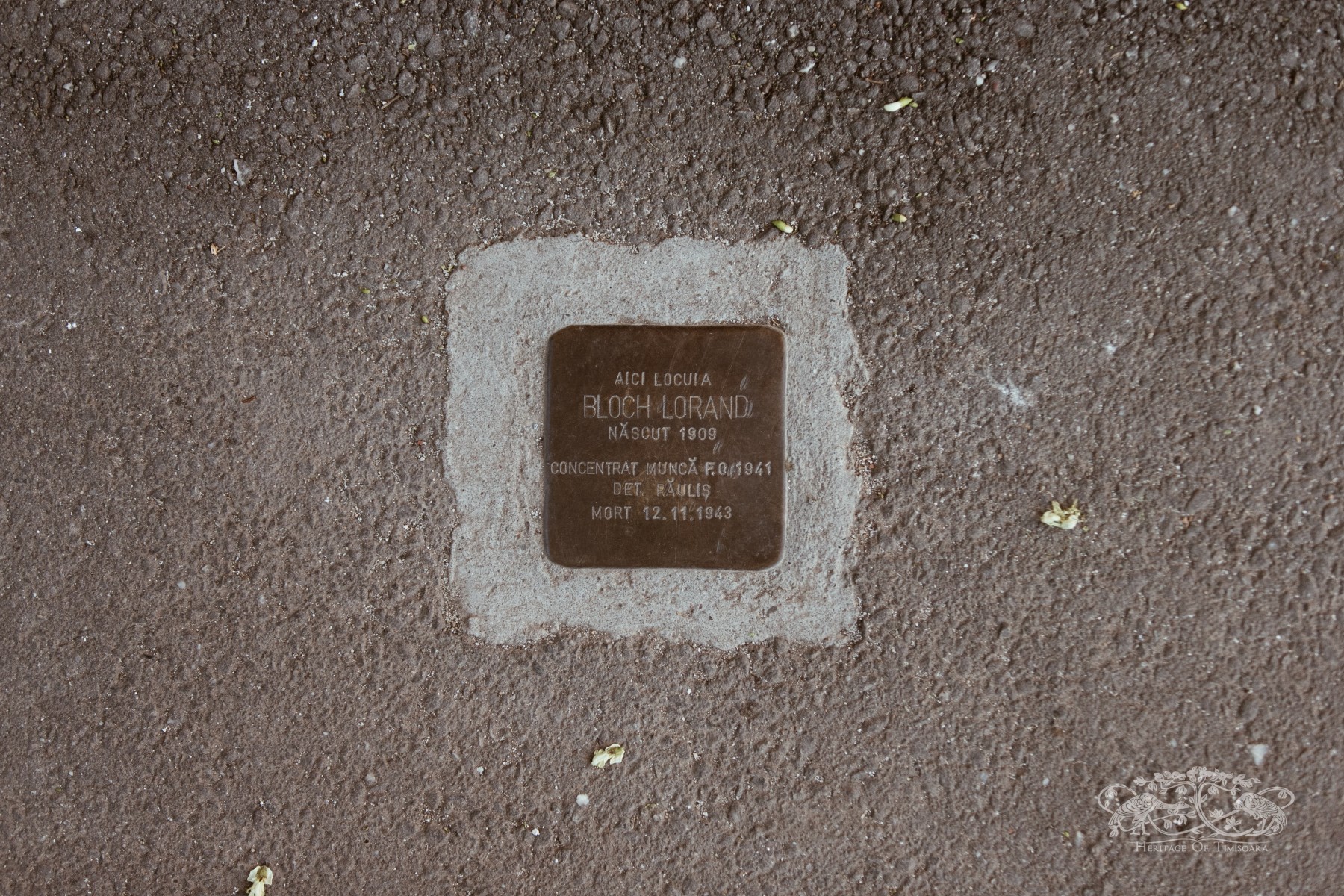According to old photograph, the historicist/eclectic house on 8 Romanilor Square, existed while the ‘Millenium’ Roman Catholic Church was being built (1896-1901). On the map of the Jewish businesses and estates in Fabric, in 1920-1930, based on Annie Hammer’s information and the book ‘Jewish Destinies in Timisoara: The Portrait of The Jewish Community From Interbelic Times Until Today’ (“Destine evreieşti la Timişoara: portretul comunităţii evreieşti din perioada interbelică până azi”), by Getta Neumann, the house appears by the name ‘Zala House’, named after the owner’s wife.
In 2014, on the sidewalk in front of the house, the first and only stolperstein in Timişoara and Romania was set, dedicated to Lorand Bloch, a Jewish former inhabitant of the house, born in 1909. In 1941, he was sent to the Păuliş-Ghioroc (Arad county) forced labour camp, where he died, on November 12th, 1943.

On a summer day, we went to Zala house, hoping we would find someone to tell us more about the building and the way the Fabric neighbourhood used to be. We met Mrs. Matilda D., who told us, smiling, that she had been living in Zala house for ‘only 66 years’. She talked to us about Lorand Bloch, the Friedmann family, and the open interior gardens, which created a passageway from Romanilor Square to Ştefan cel Mare street.
We also found out that the house now belongs to City Hall. In it, there are owners and tenants. According to Matilda D., the house ‘is very old, close to falling on us. I’ll take you inside, if you want, and you’ll see where it rains. What else can I say… I wish City Hall came and did something. It’s a pity, because it’s a historic building. It’s a pity! The house is solid, has these walls! When they put in the heating installation, the workers were surprised because the walls were 80 centimetres thick. That’s what they measured. I think, but I’m not sure, that the house is 150 years old.’
Matilda D. was present at the event in 2014, when the stolperstein was set. ‘This room with the balcony belonged to the man who died (a.n. Lorand Bloch). His son lives in France now. When he was a child, I was about 8-9 years old. He visited about 12 years ago, and we even met. His grandparents used to live here, the Friedmanns. Bloch was Friedmann’s grandson. I was born here, in the first room. Back then, my parents only had one woom. They moved here two years before I was born, in 1951, when they got the room from Friedmann. He was still here. They were very nice people. Jewish, but you could really get along with them. If there was something you couldn’t find, they said <you’ll have it by tomorrow>. And by the evening, they brought it. They were really nice people. Zala Regina was Friedmann’s wife’s name. She died before him.’
When she was little,‘Traian Square was still a market. On the other side (a.n. Ştefan cel Mare street) there were restaurants. Back then, you could pass through the common yards. The gates were open and you could go from Romanilor Sq. to Ştefan cel Mare st. Then they closed it. Everyone worked at their home. Some lost their apartments.’
‘Is used to be a very peaceful neighbourhood. About 15-20 years ago, the ruckus started. There were complaints because some people used to fight in the interior yards. The taxi drivers used to complain that they were kept waiting, because clients used to go out on the other gates. That’s when the yards were closed. It was easy for us to get to Ştefan cel Mare street. I used to work at the Batteries Factory (a.n. DURA) and I had a 5 minutes walk to work. We got used to it. I used to come from the market and take the old way and say <whoops!>. The other way, then: <Wait, this is closed too!>. Habits. You had an old habit to walk on a certain way… Now, you know, habit cures habit.’
Matilda D. is retired now, but she says she would never leave Fabric. ‘I worked at the batteries factory. I have two sons and three granddaughters. They keep asking me why I don’t move away. I told them: nothing will make me move. You will have to take me away! I don’t feel like leaving. I’m used to living here, I’m attached to this place. It’s my home. You know, for however long God will keep me here. I was baptized here at the church, I got married here, I still go to church here. Every Sunday and holiday.’
Mrs. Matilda D. allowed us to take this photo, and we want to thank her for agreeing to this interview.
You can send digital postcards with Zala House and Lorand Bloch's stolperstein from here. By doing so, you are actively contributing to promoting the cultural heritage of the Fabric neighborhood and we are grateful for this.
Photo credits 1 and 2: Flavius Neamciuc
-medium.jpg)